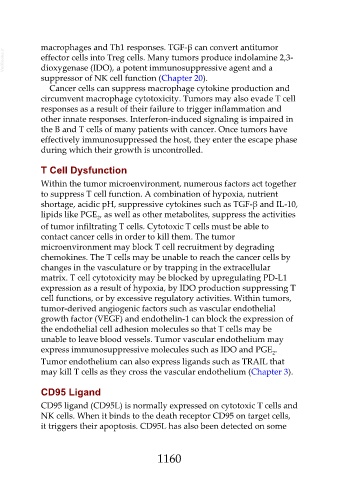Page 1160 - Veterinary Immunology, 10th Edition
P. 1160
macrophages and Th1 responses. TGF-β can convert antitumor
VetBooks.ir effector cells into Treg cells. Many tumors produce indolamine 2,3-
dioxygenase (IDO), a potent immunosuppressive agent and a
suppressor of NK cell function (Chapter 20).
Cancer cells can suppress macrophage cytokine production and
circumvent macrophage cytotoxicity. Tumors may also evade T cell
responses as a result of their failure to trigger inflammation and
other innate responses. Interferon-induced signaling is impaired in
the B and T cells of many patients with cancer. Once tumors have
effectively immunosuppressed the host, they enter the escape phase
during which their growth is uncontrolled.
T Cell Dysfunction
Within the tumor microenvironment, numerous factors act together
to suppress T cell function. A combination of hypoxia, nutrient
shortage, acidic pH, suppressive cytokines such as TGF-β and IL-10,
lipids like PGE , as well as other metabolites, suppress the activities
2
of tumor infiltrating T cells. Cytotoxic T cells must be able to
contact cancer cells in order to kill them. The tumor
microenvironment may block T cell recruitment by degrading
chemokines. The T cells may be unable to reach the cancer cells by
changes in the vasculature or by trapping in the extracellular
matrix. T cell cytotoxicity may be blocked by upregulating PD-L1
expression as a result of hypoxia, by IDO production suppressing T
cell functions, or by excessive regulatory activities. Within tumors,
tumor-derived angiogenic factors such as vascular endothelial
growth factor (VEGF) and endothelin-1 can block the expression of
the endothelial cell adhesion molecules so that T cells may be
unable to leave blood vessels. Tumor vascular endothelium may
express immunosuppressive molecules such as IDO and PGE .
2
Tumor endothelium can also express ligands such as TRAIL that
may kill T cells as they cross the vascular endothelium (Chapter 3).
CD95 Ligand
CD95 ligand (CD95L) is normally expressed on cytotoxic T cells and
NK cells. When it binds to the death receptor CD95 on target cells,
it triggers their apoptosis. CD95L has also been detected on some
1160

